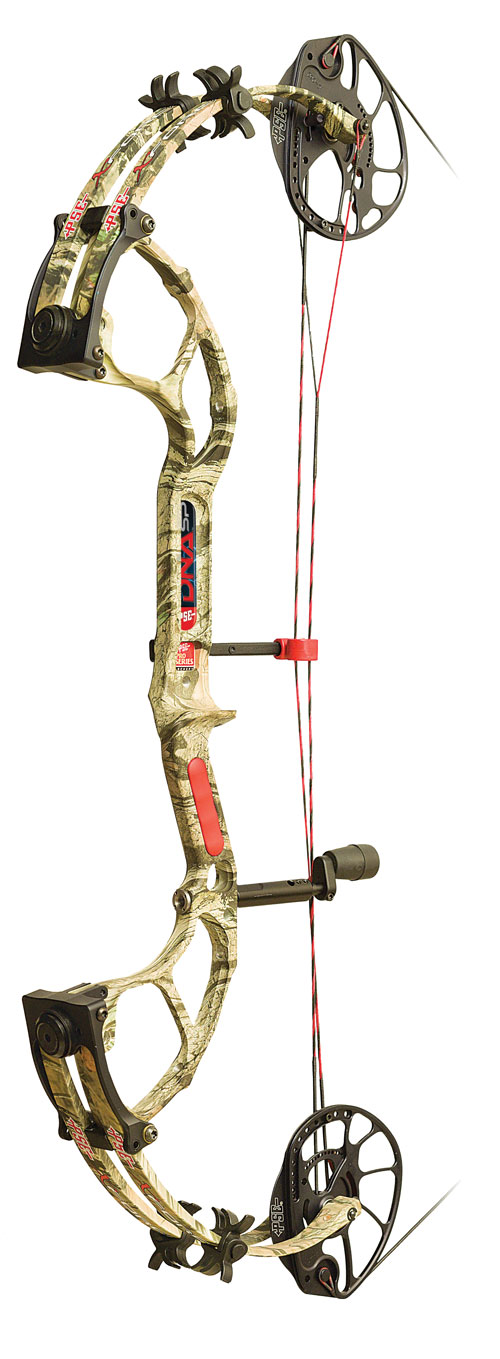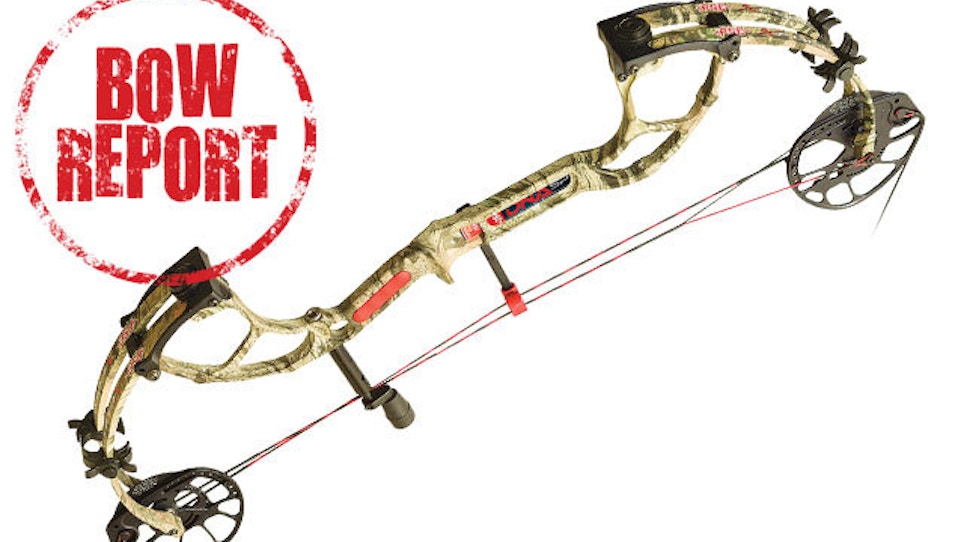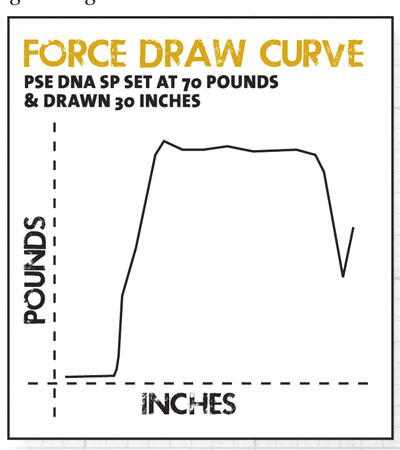"I think we have squeezed just about all the efficiency we’re going to get out of the bow machine. From here on you’ll be seeing bows getting smoother and smoother to draw—what I call ice-cream bows.” PSE founder Pete Shepley said that to me about seven years ago, and as usual he was ahead of the curve. Bows have gotten only incrementally faster since then, but on the average they have gotten a lot smoother drawing while generating much less noise. At the shot, fast bows tend to pop forward in the hand, but for the better bows hand shock has been reduced to a slight vibration and, in some cases, is virtually undetectable.
PSE’s highly successful X-Force bows have all been high performance (read “fast”) bows. Being among the fastest compound bows on the planet was a big part of their appeal, and for those shooters who demand peak speeds the DNA is still in the line-up and still generating velocities up to 352 fps. For those shooters who like speed but felt the DNA was a little harsh on the draw, PSE has tweaked the aggressive Core Hybrid Cams on the original DNA to produce the DNA SP (Smooth Pull). The new CS Cam powers the DNA SP and, by shaving 7 fps off the top speed, achieves a significant softening of the shot cycle.
 Everything else about the DNA SP remains true to the original, from the light weight (itself a significant change from most of PSE’s earlier offerings), to the characteristic long riser and short, aggressive, past parallel, pre-loaded limbs, the flexible cable guard rod, the Detachable Limb Bands, and the distinctive red sideplate grip. Brace height remains at 6 inches, adequate if not generous, but skinny enough to generate high speeds.
Everything else about the DNA SP remains true to the original, from the light weight (itself a significant change from most of PSE’s earlier offerings), to the characteristic long riser and short, aggressive, past parallel, pre-loaded limbs, the flexible cable guard rod, the Detachable Limb Bands, and the distinctive red sideplate grip. Brace height remains at 6 inches, adequate if not generous, but skinny enough to generate high speeds.
Some specs are slightly different, beginning with a nominal letoff of 75 as opposed to 70 percent. Axle-to-axle is an unnoticeable ¼ inch longer on the SP, and draw length runs from 24½ to 30 inches, as opposed to 26 to 30 inches, making the SP accessible to some shooters with shorter draw lengths.
Draw weight is adjusted by loosening set screws and turning the limb bolts in the customary manner. And though it’s a small matter, I like that the limb bolts can be turned a full 10 turns down from peak weight. On the one hand I find I can get the precise weight I want with less trial-and-error when one full turn approximates one pound of draw weight. Then too, with many bowmakers issuing stern warnings about the possible dire consequences of backing limb bolts out too far, I prefer “too far” to be 11 or 12 turns as opposed to three or four turns. (Could be I’m overly cautious, but I’ve seen what happens when compound bows come apart.)
Draw length changes are accomplished without the need to press the bow by simply unscrewing modules and rotating them to the desired position. New for this year is a sliding limb stop that allows shooters to shorten or lengthen the valley.
Shooting the Bow
PSE bows readily accommodate a variety of rests. The tuning and alignment marks on the riser make setup a breeze. Shooters accustomed to earlier PSE models will notice the light weight of the DNA SP immediately. The grip is strong point on PSE bows, skinny but comfortable.
Of course the most noticeable thing about the DNA SP is the relatively smooth draw cycle. The feel is still somewhat aggressive, as you’d expect from a very fast bow, but weight increases smoothly and the drop into the valley is not sudden, nor is the stop at the wall harsh. The cams are not grabby. Speed is evident at the shot, and the bow jumps forward in the hand, but vibration and noise are minimal. Clearly, most of the energy released in the DNA SP is transferred to the arrow.
The DNA bows are designed with the nock point at the vertical center of the bow. Does that contribute to a sense of forgiveness when shooting this bow? Don’t know, and in any case that would be impossible to measure. Whatever the reason, though, and subjective as the impression may be, the DNA SP struck me as rock-steady at full draw and very forgiving.
All things considered, the DNA SP is a great addition to PSE’s line-up, and should expand PSE’s appeal to include some bowhunters who have not in the past been a fan of PSE’s commitment to high speed. Bow makers have for a few years been backing off 10 to 15 fps from top speeds to produce bows with more pleasant shooting characteristics. The DNA SP achieves a similar result while shaving off about 7 fps to arrive at what will no doubt be the sweet spot for shooters who want smooth-shooting bows without sacrificing performance.
PSE DNA SP Specs
Letoff:...................................... 75%
Brace Height:........................ 6 inches
Weight:..................................... 3.8 pounds
Axle-To-Axle Length:....... 311⁄4 inches
Speed:....................................... 345 - 337 fps
Draw Lengths:...................... 241⁄2 to 30 inches
Draw Weights:...................... 50, 60, 65, 70 pound peak weights, adjustable down 10 pounds from peak.
Options:................................... Skullworks, Mossy Oak Break-Up Infinity, and Solid Black finishes.
Suggested Retail:.............. $899.99
Objective Tests (30 Inches Draw)
Peak Hold*:............................ 70 pounds
Weight, Full Draw*:........... 18 pounds
*Rounded to nearest half-pound
At 70-Pound Draw Weight
Arrow Weight @ Launch @ 20 Yards K.E. @ Launch K.E. @ 20 Yards
385 grains 315 fps 301 fps 85.0 ft. lbs. 77.5 ft. lbs.
500 grains 306 fps 298 fps 104.0 ft. lbs. 99.0 ft. lbs.
At 60-Pound Draw Weight
385 grains 297 fps 285 fps 75.5 ft. lbs. 69.5 ft. lbs. 57.8 dBA
500 grains 290 fps 284 fps 93.5 ft. lbs. 89.5 ft. lbs. 57.0 dBA







